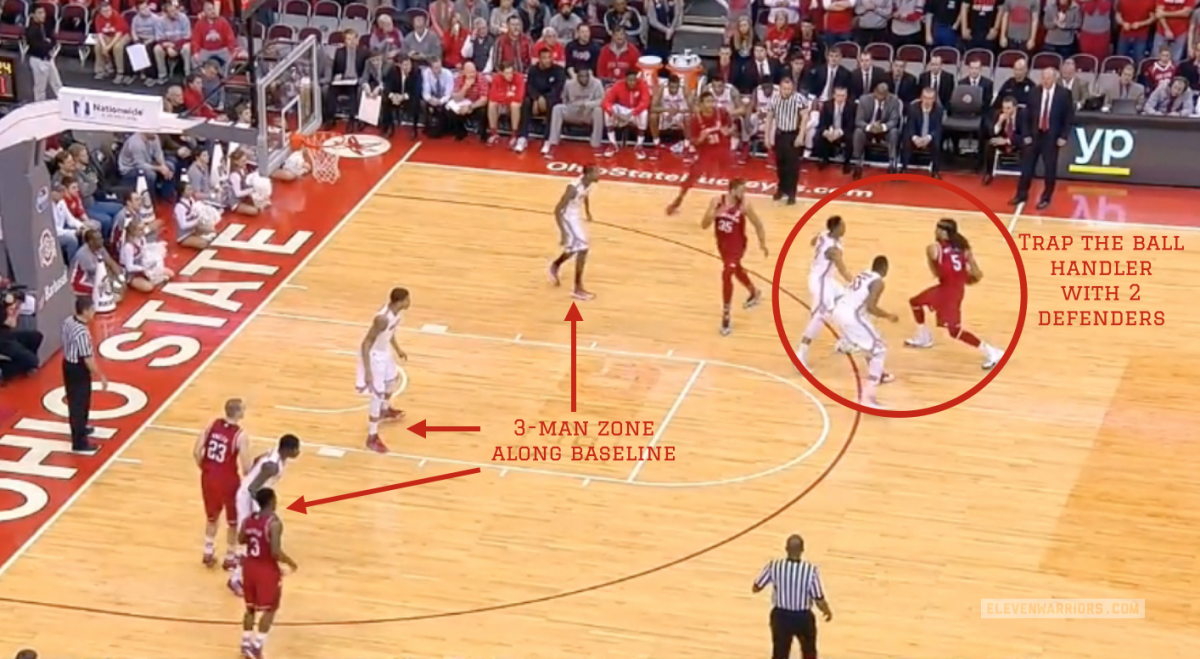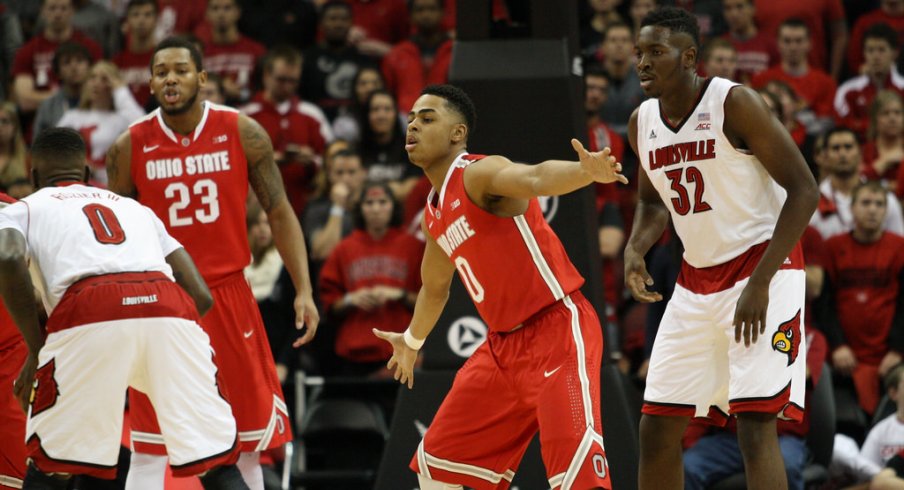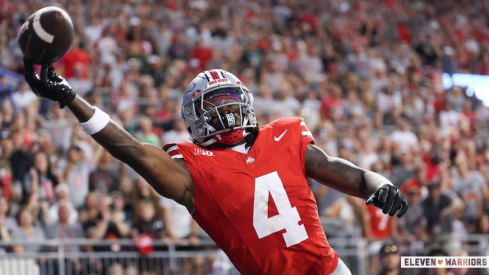Throughout Thad Matta's tenure as the leader of the OSU basketball program, his teams have consistently been one of the top defensive teams in the nation. Coming off a season in which the squad finished third nationally in KenPom.com's defensive efficiency, the Buckeyes could expect to continue the tradition of strong defensive play with four senior contributors returning, a rarity in college basketball these days.
Shannon Scott remains an excellent on-ball defender, while Sam Thompson seems to have figured out how to use his freakish athleticism to take on the top wing players in the Big Ten. D'Angelo Russell certainly possesses the requisite size and quickness to make noise defensively, although he has rarely been tasked with shutting down an opponent thanks to the load he carries offensively.
But the Buckeyes haven't lived up to their own standard this winter, clocking in at 36th in the defensive efficiency rankings. While the numbers are in their favor when it comes to blocks and steals, Matta's bunch has been plagued by inconsistencies on that end. While much of the conversation surrounding these efforts have been around the occasional experimentation with zone defenses, a larger issue appears to be the manner in which the team handles opposing screens.
The inability to handle a screen, either on the ball or off, can undo even the greatest efforts of individual defenders. The way a team decides to handle pick-and-rolls can define them as much as their starting lineup.
There is no hard and fast rule that dictates the 'correct' way to defend against a screen, with and all five players on the court must give good effort and communicate. But understanding the strengths of your own team, as well as that of your opponents is the most crucial.
While many of the Buckeye wing players fit in the 6'4" to 6'7" range, they're often able to easily switch on any perimeter screens without much problem, an approach that is paying off for the Golden State Warriors. OSU's problems have come against opposing post players setting screens for their guards, putting big men like Amir Williams and Trey McDonald in uncomfortable positions.
Looking back at the February loss to Michigan State in East Lansing, we can see how the Spartans picked apart that screen defense. On one of the Spartans' first possessions of the game, Denzel Valentine receives an easy handoff 25 feet from the hoop, as Sam Thompson checks him on defense. As Valentine dribbles back toward the top of the circle, center Matt Costello sets a screen on Thompson that everyone in the Breslin Center saw coming.

Costello's man, Amir Williams, doesn't move his feet at all, allowing Thompson to be taken out of the play and leaving Valentine with an easy spot up three. However, when looking at the game's final play, it appears as if Williams may not have been supposed to step out on Valentine at all.
When Valentine's number was called on what turned out to be the game-winning shot, we see the Buckeye center drop back after an initial screen to what is known as a 'zone' look. After following Costello out to the perimeter, who then set a pick for point guard Travis Trice, Williams immediately back pedals to the lane to cut off any quick roll action from Costello as well as discouraging Trice from trying to drive to the rim.

Williams is effectively letting the ball handler's man (in this case Shannon Scott) to chase any action on the outside, while he takes over a zone in the paint. This is a scheme called by many NBA teams with big, rim-protecting centers like Roy Hibbert or DeAndre Jordan, and at 6'10" Williams would certainly fit that mold at the college level.
But because Williams is retreating and looking to cover the paint, no one is paying attention to Costello, who sets a screen off-the-ball for Valentine yet again, who sets up for an uncontested catch-and-shoot opportunity.
While the 'zone' tactic is effective at stopping any cutters down the lane and protecting the rim, it leaves the perimeter exposed. Clearly Matta felt more comfortable leaning on players like Scott or Thompson to take on larger roles in these screen situations, but the Spartans were more than happy to take the open outside shots that resulted.
After the Buckeyes surrendered seven three-pointers to opposing guards in the following week's upset loss in Ann Arbor, Matta clearly felt it was time for a change. As the Buckeyes took the floor at home against Nebraska this past Thursday, a new tactic was in place.
Instead of giving perimeter players like wing Terran Petteway the space to operate, the Buckeyes 'blitzed' the Huskers on the perimeter, effectively double-teaming the ball handlers with both defenders involved on the play. Meanwhile, the remaining three OSU defenders slide slightly off their men and effectively play what would be the back-half of a 2-3 zone, with one man in the paint and two on the wings.

As the Husker big man who set the screen (#35 Walter Pitchford) rolls to the hoop, Marc Loving slides right in his way, cutting him off in the middle of the lane. Though the now-rushed Pitchford is able to find a baseline cutter, it's for an awkward layup that doesn't go in, a situation the Buckeyes would much rather find themselves in than allowing Petteway to attack.

The blitz is a risky maneuver that puts a lot of pressure on the back three defenders, as it asks them to defend four guys. But that window is very short, and is often on a rushed ball handler to no only find the open man, but to deliver a good pass, something rolling big men aren't used to doing at the college level.
But when facing a team anchored by a talented big man, such as last night's matchup with Purdue center A.J. Hammons, the Buckeyes made a slight adjustment. On the game's very first possession, the Boilermakers ran a handoff screen with Hammons and point guard John Octeus.
But instead of both players trapping Octeus, Williams uses the 'Show' technique, shuffling over to contain the ball handler until Scott could recover from the screen. By keeping his long arms extended and moving aggressively toward the middle, Williams completely cut off Octeus' path to the rim.

The Buckeyes would cut off pick-and-rolls with Hammons like this all night, including a critical stop late in the game. Coming out of a timeout, Purdue called for a traditional, high-ball screen with Hammons setting a pick on Scott again.
As Williams "showed" yet again, Hammons cut hard to the rim. But instead of looking to get back on Octeus, Scott recognizes the hard cut and follows the big man, fronting him in the post while Williams stays on the ball handler. Instead of getting the ball inside to their best player, the Boilers have to settle for a contested three as the shot clock runs down, allowing OSU to get an easy rebound that would lead to the go-ahead score.

While Williams' effort was key in both situations, Matta is still leaning on Scott to run the show in this situation. As far as Williams is concerned, he is effectively "switching" men with Scott until told otherwise, with the decision to do so made by the senior point guard.
In the first example, Scott didn't see a threat in Hammons' movement, so he could quickly recover and allow the defense to reset. In the latter, Scott and Williams swap roles, knowing that Purdue only has a few seconds to get a shot off.
As the Buckeyes head into March, now on a two-game winning streak, the Buckeyes appear to be in a much better place defensively than they were just a week ago. Tough tests await next week against Wisconsin, and the following week in the Big Ten tournament. But as UConn showed last year, a team can make a very deep run thanks to great offensive play from a guard, as well as great team defense.
The Buckeyes have had the former all season-long with Russell. Have they finally found the latter?


